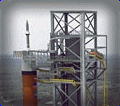
As, since 2008, the Obama administration radically modified the 2004 Bush plan in terms of U.S. space program and debates and theories obscuring the new U.S. paths to space after the retirement of the Space Shuttle fleet, devices, construction and flights are now keeping on, mostly performed by private companies to test and improve the launchers and capsules they are to provide to the USA to provide a access to the ISS and manned low Earth orbit (data updated monthly; last updated Oct. 27th, 2014)
| Next Missions Past Missions | Varied Tests, Construction, Etc. |
(by order of scheduled launch. Note! Once commercial companies cargoing to the ISS entering the effective phase of their flights, such flights are to be referenced in the ISS flights section)
- no item in that section -
(by reverted chronological order)
![]() Orion Capsule Exploration Flight Test-1
Orion Capsule Exploration Flight Test-1
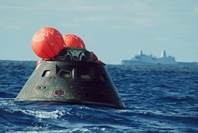 | The Orion capsule in the Pacific Ocean after its successfull flight test on Dec. 5, 2014. picture NASA |
Orion Capsule Exploration Flight Test-1 The first launch attempt of the unmanned, Orion Exploration Flight Test-1, from the Space Launch Complex 37 at Cape Canaveral Air Force Station in Florida, on December 4th, 2014, endured varied causes of delay, of which due to weather and about technical issues in terms of hydrogen valves. As a launch time had been eventually set to 9.44 a.m. EST from a original 7.05 a.m. -which was the end of the launch window- NASA took the decision to stop the launch process. The second launch attempt was the one, as scheduled and performed at 7:05 a.m. EDT on Dec. 5, 2014. The craft successfully managed to the orbit atop its two-stage Delta IV Heavy rocket, as it remained attached to the second until reentry in the Earth's atmosphere. After one orbit in the low Earth orbit, a burn of the second stage engine propelled the test assemblage up to 3,604 miles (5,800km) into the Van Allen radiation belt as that was reached at T+3 hours and 6 minutes. Such a point is farther than any manned spacecraft has traveled in more than 40 years. Gravity pulled back as the Orion separated from the Delta IV Heavy second stage and the capsule re-entered the atmosphere at a speed of 20,000 mph (32,000km/h) enduring temperatures near 4,000 degrees Fahrenheit (2,200 degrees Celsius), with a blackout of 2 ½ minutes. The capsule splashed down in the Pacific Ocean by about 20 mph under three parachutes, by 620 miles off the coasts of Baja California. From Naval Base San Diego, San Diego, Calif., two Navy ships, the USS Anchorage and the USNS Salvor, returned Orion to land aboard the former one. A new countdown clock at the Kennedy Space Center had been installed for the occasion, to replace the old one. The Orion capsule is manufactured by Lockheed Martin and that flight test allowed to test the new capsule miscellaneous systems along with recovery or ground control systems. The next step should be a 25-day mission, in 2017 sending Orion more than 40,000 miles beyond the Moon into a deep retrograde orbit where a asteroid could be relocated in 2021 and allow engineers to evaluate the performance of the SLS and assess the systems designed to support a crew in Orion before the capsule begins carrying astronauts
![]() Orbital 1 Commercial Resupply Services Flight
Orbital 1 Commercial Resupply Services Flight
Orbital Sciences Corporation successfully performed its first commercial to the ISS, starting with a launch on Jan. 9, 2014. The launch had been postponed due to a solar storm which could have interfered with the mission computer systems. The launch of the Cygnus capsule occurred atop a Orbital Sciences Corporation Antares rocket from the Mid-Atlantic Regional Spaceport Pad 0A at NASA’s Wallops Flight Facility in Virginia. After two and a half days the Cygnus tracked the ISS and rendezvous with the outpost where it was grappled and berthed at the Harmony node. The flight was carrying 2,780 pounds of supply as it will remain docked until mid-February and undocked for a destructive re-entry over the Pacific Ocean
![]() SpaceX Improved Falcon 9 Rocket Test Flight
SpaceX Improved Falcon 9 Rocket Test Flight
SpaceX successfully a improved Falcon 9 rocket from Space Launch Complex 4 at Vandenberg Air Force Base in California on September 29th, 2013 carrying a Canadian satellite and three small satellites. That rocket is planned to launch the next crew-carrying Dragon. The new Falcon 9 is featured with a restartable first stage, which is part of reusability test, and nine new Merlin 1D in a circular pattern
![]() Orbital Sciences Corporation Cygnus Capsule Test Flight to The ISS
Orbital Sciences Corporation Cygnus Capsule Test Flight to The ISS
Orbital Sciences Corporation successfully launched its Cygnus capsule on a test flight with a Antares rocket, to the International Space Station (ISS) on September 18th, 2013 from Mid-Atlantic Regional Spaceport Pad 0A at Wallops Flight Facility, Va. as the arrival at the outpost was delayed due to inaccurate navigation data and the capsule had then to wait for a Russian Soyuz ferrying astronauts. The Cygnus eventually was grappled at the ISS' Harmony node one week after its original arrival date as a software fix had been sent to the craft and the latter successfully performed demonstration approach objectives. The Cygnus departed the ISS on Oct. 22, 2013 after released through the ISS robotic arm and a 3 weeks stay. Unlike the SpaceX Dragon that can return items to Earth, the Cygnus is designed to burn up upon descent. It can carry 2 tons of cargo to the station
![]() Orbital Sciences Corporation Antares Launcher Test Flight
Orbital Sciences Corporation Antares Launcher Test Flight
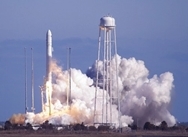 | The Orbital Sciences Corporation Antares launching on its successful test flight on Apr. 21, 2013. picture NASA/Bill Ingalls |
Orbital Sciences Corporation succesfully launched its Antares rocket launched on Apr. 21st, 2013 from the new Mid-Atlantic Regional Spaceport Pad-0A at NASA's Wallops Flight Facility in Virginia. The rocket had been moved to the pad on Apr. 6. The company's Taurus II, had been renamed 'Antares,' as that flight was part NASA’s Commercial Orbital Transportation Services agreement with the company
![]() SpaceX-2 Commercial Resupply Services flight
SpaceX-2 Commercial Resupply Services flight
The ISS welcomed its second contracted cargo delivery flight on Mar. 2, 2013 with the arrival of the SpaceX Dragon carrying a treasure trove of cargo, hardware and supplies for the Expedition 34 crew. The Dragon is scheduled to stay more than three weeks at the ISS and then released to splash into the Pacific Ocean as it had launched aboard a Falcon 9 rocket from the Kennedy Space Center on the previous day. The rendezvous with the station was delayed a day in the wake of a temporary loss of three of four banks of thrusters after Dragon separated from the Falcon 9 rocket. The SpaceX Dragon fired its engines on Mar. 26, 2013, sending it through the Earth’s atmosphere for a splashdown in the Pacific Ocean. A team of SpaceX engineers, technicians and divers will recover the vehicle and its scientific cargo off the coast of Baja, California, for the journey back to shore which will take about 30 hours. The Expedition 35 crew commanded the spacecraft to slowly depart from the International Space Station. Ground controllers earlier sent commands to the Canadarm2 to unberth Dragon from the Harmony node. Dragon's return date, originally scheduled for March 25, was postponed due to inclement weather developing near its targeted splashdown site in the Pacific Ocean
![]() SpaceX-1 Commercial Resupply Services flight
SpaceX-1 Commercial Resupply Services flight
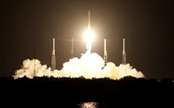 | A view of the SpaceX CRS-1 mission to the ISS lifting off from the Kennedy Space Center on October 7th, 2012. picture NASA |
The 'Commercial Resupply Services,' or CRS-1 mission successfully began October 7th, 2012 when it launched atop a Falcon 9 rocket from launch pad 40 at Cape Canaveral Air Force Station in Florida. It is the first of 12 ressuply flights to the ISS. The capsule was captured at the ISS through a robotic arm on October 10th, and expected to stay three weeks there. The compagny's mission control center is located in Hawthorne as NASA monitored the orbital rendezvous from its station Mission Control at the Johnson Space Center in Houston. The SpaceX Dragon cargo-craft returned safely Earth on Oct. 10th, 2012, parachuting into the Pacific Ocean and completing the first official shipment under a contract with NASA. SpaceX company successfully guided the Dragon down from orbit to a splashdown 250 miles off the Baja California coast. The ship brought back nearly 2,000 pounds of science experiments and old station equipment
![]() SpaceX Falcon 9/Dragon Mission to The ISS
SpaceX Falcon 9/Dragon Mission to The ISS
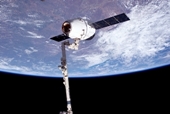 | A view of the Dragon commercial cargo ship as grappled by the ISS Canadarm2 robotic arm. That flight was the first ever commercial flight to the Space Station by May 2012. picture NASA |
The Dragon spacecraft successfully flew it first flight, and the first ever commercial cargo flight to the ISS! The Dragon capsule further is a recoverable one. The Dragon capsule lifted off on May 22nd, 2012 from the Cape Canaveral Air Force Station, at the Kennedy Space Center, Space Launch Complex 40, aboard a SpaceX Falcon 9 rocket. The Dragon cargo craft brought 1,014 pounds of supplies to the station as the ISS Expedition 31 crew grappled the craft through the Canadarm2 robotic arm on May 25th, 2012 and berthed it to the Earth-facing side of the station’s Harmony node. The craft further was bolted to the module. Following a series of system tests and a successful fly-under of the space station on the previous day, the Dragon capsule was cleared by NASA to approach the ISS Friday. Dragon then performed a series of intricate test maneuvers as it approached the orbiting laboratory. These maneuvers were required to demonstrate the maneuvering and abort capability of Dragon prior to approaching and moving into a 65-foot (20-meter) berthing box where it was grappled. The mission further was successful with the undocking of the Dragon capsule on May 31st, 2012 like planned. The Dragon was first maneuvered it to a 33-foot release point and un-grappled there as it deorbited approximately four hours after leaving the station, taking about 30 minutes to re-enter Earth's atmosphere and landing in the Pacific Ocean about 250 miles west of southern California where it was recovered by boats after maritime surveillance P-3 Orion aircraft had spotted the splashing area. The craft was shipped to the Port of Los Angeles and then to SpaceX's McGregor, Texas, facility, about 100 miles (160km) south of Dallas. The Dragon brought back 1,400 pounds of old ISS gear. The Dragon is a 19-foot (5.8m) tall, 12-foot (3.6m) wide vehicle and the sole private recoverable cargo ship as others are intended to burn at reentry. Regular cargo runs to the ISS by the Dragon could begin as soon as by next fall 2012. A first launch attempt had occurred on May 19th, 2012 and interrupted. The SpaceX had been given NASA's go-ahead to the Dragon cargo craft to fly and dock to the International Space Station (ISS), a première in the world of the private space companies. SpaceX will charge NASA at least $1.6 billion for 12 cargo shipments to the ISS in 4 years, or $133 million per flight compared to the cost of $1 billion per flight for the late space shuttle. Upon successful completion of the mission, SpaceX will receive an additional $396 million from the space agency. The Freedom Star and its sister ship, Liberty Star, which were built to recover The Space Shuttle program solid rocket boosters, also tracked the spacecraft during the mission, off the coast of the northeastern United States using a high tech camera and a radar. for more check at NASA site
![]() SpaceX Falcon 9 Test Flight
SpaceX Falcon 9 Test Flight
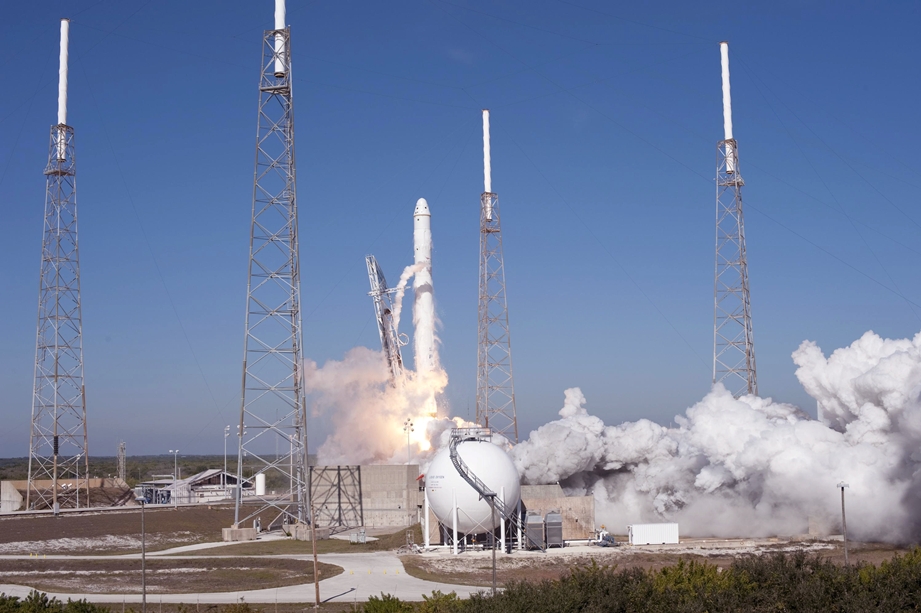 | A view of the the Dec. 8, 2010 COTS-1 test flight launching from launch pad 40 at the Kennedy Space Center. picture NASA/Tony Gray and Kevin O'Connell |
Commercial Orbital Transportation Services-1 (COTS-1) test flight of the SpaceX Falcon 9, a rocket and the Dragon capsule participating into NASA suppletive operations like reaching the ISS. The Falcon 9 launcher successfully lifted off from pad 40 from the Kennedy Space Center, CCAFS, by Wednesday, Dec. 8, 2010 at 10:42 a.m. EST. Launch had been delayed from the previous day due to cracks in laucher's second-stage rocket engine nozzle. The launch on Dec. 8 was further delayed by about one hour and a half for cause of false telemetry readings. That test was the first flight ever under NASA's Commercial
Orbital Transportation Services (COTS) program designed to encourage the
development of private launch and vehicle systems to the ISS, for the transportation of cargo and possibly crew
The Dragon capsule successfully performed a 3-hour orbital journey at a speed of 17,000 mph as it re-entered safely the Earth's atmosphere, with three parachutes deployed and a landing in the Pacific Ocean. The reuseable Dragon capsule might transport up to 6 crew to the ISS as it might also land on ground
SpaceX Falcon 9 Test Flight. Splashdown occurred 500 miles West of the coast of Mexico
LATEST! (last updated: 31/10/09)
With a scheduled launch October 27th, 2009, by 8:00 a.m. EDT., the Ares 1-X successfully launched on Wednesday, October 28th, by 11:30 a.m. EDT. This launch is a success as the statistics prove that about 40 percent of all new rockets end in failure, usually. The new rocket of NASA had to wait one day for cause, mainly of weather as the launch was further postponed during the morning of Wednesday for the same causes! NASA was needing a 5 to 6 minute window of clear skies as the countdown had been halted by the T-minus 4-minute hold mark since Tuesday morning. NASA needed too that static-filled clouds and high-altitude winds be unextant. The ignition system eventually armed, the water and electrical systems activated. The rocket reached Mach 2 and burned out by 22.2 nautical miles of altitude. The Ares 1-X launched from launch Pad 39B which has now been converted for the Constellation program. NASA used the Space Shuttle booster-retrieval ship Freedom to recover the Ares from the Atlantic Ocean and unluckily found that something had went wrong with 2 of the 3 150-foot (46-meter) parachutes which were meant to slow down the splasdown of the Ares I-X booster down to the ocean. The booster thus touched down harder than expected and has been damaged with a large dent. One chute seems to have deflated during the fall. The failure might have occurred at the moment of the separation between the booster and the mock second stage. Engineers are now going to try to sweep the flight data to better understand what went wrong
. The launch window for this first test of the Ares I was running Oct. 27-Nov. 16, as NASA had expanded it that way. The Ares I-X had rolled out to launch pad 39B on Tuesday, October 20th, as the rocket was moved atop the crawler-transporter used for the Space Shuttle program (which itself had taken it back from the Apollo program). The tip of the Ares was allowed to sway up to 1ft (0.3 m) during the transport
. The four cylindrical segments making up Ares I-X's first stage had arrived at Kennedy Space Center March 19 from the Alliant Techsystems facility in Utah, already fueled as the segments were to be stacked later in the Vehicle Assembly Building (VAB). The total height of the test rocket will be of about 320 ft as the flight will launch from launch pad 39B. NASA conducted the first successful test firing of the Ares I rocket's first stage on Sept. 10. The previous scheduled launch date was for Oct. 31 as engineers were able to complete earlier their work on the booster. The actual launch target will be finalized by mission managers during a series of review meetings, as a launch countdown simulation already was performed in September
. The Ares I-X is the first real time flight test of the Ares I, one of both new launch vehicles of the Constellation program, focusing on the first stage of the new NASA launcher. Only the first four segments of the first stage will be active for the Ares I-X test. A fifth segment, the upper stage and an Orion spacecraft at the top will be sensor-laden mass simulators. The Ares I-X test flight will provide NASA with an early opportunity to test and prove hardware, facilities and ground operations associated with the Ares I. The first stage of the Ares I is based on a Space Shuttle’s solid rocket boosters, which have always flown in pairs until now. The upper stage simulator will not fly for long. After the first stage burns out about two minutes after liftoff, at an altitude of about 25 miles (40 km), it will separate and the upper stage will soar along unpowered until it splashes down in the South Atlantic Ocean. Launch pad 39B had to be refitted for the Ares I-X rocket
. The Ares I is to propell into orbit or on a lunar mission NASA new CEV manned capsule as the Ares V is the heavy launcher which will be used for the lunar missions only, lifting into orbit the modules to be coupled to the CEV to a Moon mission. more about the Constellation program!
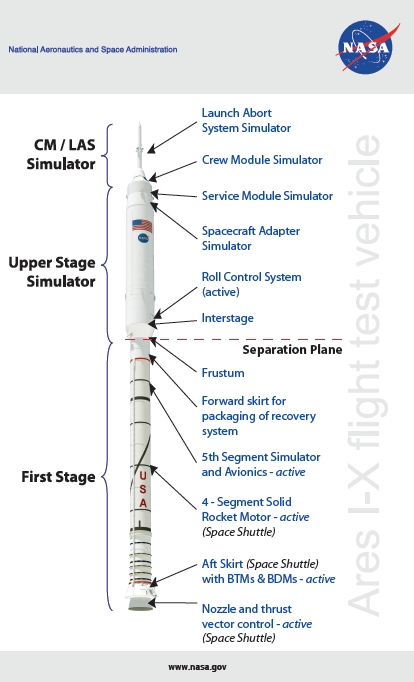 | a view of how the Ares I-X will be configured for its test flight. click to a larger picture. picture NASA |
(news by reverse chronological order, recentest first)
. May 2014. First Simulation of Launch and Flight Control of A Orion's Flight
First joint integrated simulation, with the Flight Control Team along with the Mission Management Team,
the Test and Launch Control Center and the Engineering Support Team, all located
in at NASA's Kennedy Space Center in Florida, was performed in May 2014, covering pre-launch and
in-orbit phases of a Orion’s mission
. April 2014. The Orion Capsule Powered During 26 Days! First Flight Test Later in 2014!
NASA's Orion spacecraft ran for 26 uninterrupted hours during the final phase of a major
test series completed April 8 at the agency's Kennedy Space Center in Florida.
The test verified the crew module can route power and send commands that enable
the spacecraft to manage its computer system, software and data loads,
propulsion valves, temperature sensors and other instrumentation. The first flight test is now scheduled few month after that test as NASA will fly the capsule in space and return it safely Earth
. December 2012. The SLS Core Stage Design Review Keeps 2017 Like a Targeted Date for The System First Flight Test!
The core stage of the SLS successfully passed a preliminary design review (PDR). The purpose of the PDR was to ensure the design met system requirements within
acceptable risk and fell within schedule and budget constraints. An important
part of the PDR was to prove the core stage could integrate safely with other
elements of the rocket's main engines and solid rocket boosters, the crew
capsule and the launch facilities at NASA's Kennedy Space Center in Florida.
Core stage designers provided an in-depth assessment to a board of engineers
comprised of propulsion and design experts from across the agency and the
aerospace industry. Each individual element of this program has to be at the same level of maturity
before they can move the program as a whole to the next step as the core stage is the rocket's central propulsion element and
will be an optimized blend of new and existing hardware design, with longer tanks, longer feed lines and advanced manufacturing processes. SLS first flight thus keeps being scheduled for 2017. The core stage will be built at NASA's Michoud Assembly Facility in New Orleans as the plant continues modifying
its facilities for construction of the rocket
. March 2012. A Major Step in Terms of Review for The SLS System!
March 29, 2012 a review teams completed, about the new SLS system of launchers and capsule, the first step in a combined System
Requirements Review and System Definition Review or parallel studies that set
requirements to narrow the scope of the system design and evaluate the vehicle
concept. The reviews include
setting launch vehicle requirements for crew safety and interfacing with the
Orion Multi-Purpose Crew Vehicle to carry it to deep space as well as the ground
operations and launch facilities at NASA's Kennedy Space Center in Cape
Canaveral, Fla. Additionally, the reviews set cost and schedule requirements to
provide on-time development. This is the beginning of series of life-cycle reviews advancing the
vehicle from concept design to flight readiness. Step one included a focused
technical review of the program requirements with information on cost, schedule
and risk. Step two, which will begin in early summer, will include an integrated
assessment of the technical and programmatic components fully evaluating cost,
schedule and risk involved with the SLS program. A first launch of the SLS is now scheduled in 2017
. March 2012. Scaled Down Replica of the Space Launch System's Solid Rocket Motors Tested At The Marshall Space Flight
Center
Scaled down, low-cost replica of the solid rocket motors that will boost the Space Launch System (SLS) have been tested by March 2012 by engineers at NASA's Marshall Space Flight
Center in Huntsville, Ala. Such a test help engineers develop and evaluate analytical models and skills
to assess future full-scale SLS solid rocket motor tests. The next full-scale
test, Qualification Motor-1 (QM-1), is targeted for spring 2013. Marshall's Engineering Directorate designed the test motor with
support from ATK Aerospace Systems of Huntsville, Ala. ATK of Brigham City,
Utah, the prime contractor for the SLS booster
. November 2011. The New SLM Mobile Launcher and New Launch Pad 39B Moving Ahead
Part of the new Space Launch System (SLS) which is to provide NASA a new heavy launcher and capsule for flights beyond the Earth orbit, a new launch tower under the form of a mobile launcher, or ML, is to be used as transported atop a crawler-transporter to Pad 39B, which has undergone extensive
renovations during the past year (the tower that stood
at the pad, which was specifically built for the shuttle, was removed recently
and workers refurbished the pad complex's network of lines and plumbing). Rising 400 feet, the mobile launcher is substantially
different than the mobile launcher platforms that carried space shuttles to the
launch pads for 30 years. The dominant feature is the ML's tower, a
355-foot-high gray, steel tower reminiscent of the ones that serviced the Saturn
V rockets headed to the moon in the 1960s and 70s. Not since 1975 has a launch structure as tall as the ML stood at either
of Kennedy's launch pads. Its
worksite is beside the Vehicle Assembly Building. Swing arms will be added to the tower in the 2015 time frame to provide fueling
and venting, along with electrical and communication links, to the different
stages of the rocket. A crew access arm also will be added. The launch pad
likely will need a redesign of the flame deflector and refurbishment of the flame trench.
Unlike other pad designs at Kennedy, Pad 39B now is envisioned to have a flexible
concept so it can host several kinds of rockets. The Launch Equipment Test Facility, or LETF is a laboratory built so evaluate
full-size segments of ground support equipment
. August 2010. The Five-Segment Solid-Rocket-Motor Successfully Tested at Cold Temperatures
NASA and ATK successfully tested the five-Segment
Solid Rocket Motor (SRM) under cold conditions, by 40 degrees F (5° C) on Aug. 31, 2010. The stationary firing of the first-stage development solid rocket motor, dubbed
DM-2, was the most heavily instrumented solid rocket motor test in NASA history. The first development motor test had occurred last year at ambient temperature. Although similar to the solid rocket boosters that help power the Space Shuttle
to orbit, the five-segment development motor includes several upgrades and
technology improvements like the addition of a fifth segment, a larger nozzle
throat, and upgraded insulation and liner
. May 2010. The Orion Capsule Launch Abort System Successfully Tested!
By May 6th, 2010, the takeoff and ascent launch abort system for the Orion capsule has been successfully tested in New Mexico. The system, akin to the Apollo program system is composed of a extracting motor taking the capsule away from the launcher, a steering motor controlling the capsule attitude hereafter, and a jettison motor getting the abort system distant from the capsule' nose cone allowing for the parachutes to extract. Such a test occurred despite that the Obama administration scraped the Constellation program, only allowing the Orion capsule to serve like a life boat to the International Space Station (ISS)